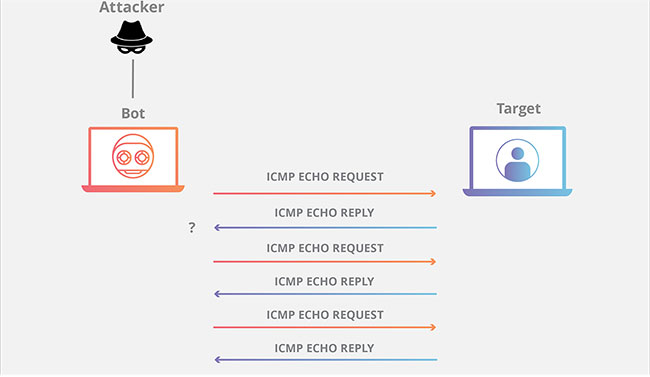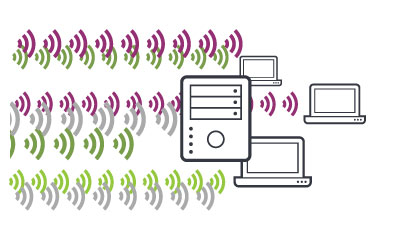What is DDoS ICMP Flood?
Typically, ICMP echo-request and echo-reply messages are used to ping a network device to diagnose the device's health and connectivity, and the connection between the sender and the device. By flooding the target with the request packets, the network is forced to respond with an equal number of reply packets. This makes the target inaccessible for normal traffic.
Other types of ICMP request attacks may involve custom tools or code, such as hping and scapy. Attack traffic emitted by multiple devices is considered a distributed denial of service (DDoS) attack. In this type of DDoS attack, both the incoming and outgoing channels of the network are overwhelming, consuming significant bandwidth and leading to denial of service.

What are the signs of an ICMP Flood attack?
An ICMP Flood DDoS attack requires an attacker to know the target's IP address. Attacks can be divided into 3 categories, determined by the target and how the IP address is resolved:
Revealed local target - In this type of DDoS attack, the Ping Flood attack targets a specific computer on the local network. In this case, the attacker must obtain the destination IP address in advance.
Router revealed - Here, the Ping Flood attack targets routers with the aim of interrupting communication between computers on the network. In this type of DDoS attack, the attacker must have the internal IP address of the local router.
Blind ping - This involves using an external program to reveal the IP address of the target computer or router before launching a DDoS attack.
Why are ICMP Flood attacks dangerous?

Because the ICMP Flood DDoS attacks overwhelm the targeted device's network connections with bogus traffic, legitimate requests are blocked. This scenario constitutes a critical level of a DoS or DDoS attack (in the case of multiple coordinated attacks).
What makes this attack vector even more dangerous is that in the past, attackers would forge a false IP address to conceal the sending device. But with today's sophisticated botnet attacks (especially IoT-based bots), the attackers don't even bother to conceal the bot's IP. Instead, they use an extensive network of bots that have not been tampered with to overwhelm the target server.
You should read it
- What is HTTP Flood?
- DDoS IP/ICMP Fragmentation attack
- What is Volumetric DDoS Attack?
- Warning the emergence of ransomware DDoS attack, the scale can be up to 800Gbps
- What is DDoS Extortion attack?
- Yandex suffered the largest DDoS attack in history
- 5 Things You Didn't Know About DDoS attacks
- How to prevent DDoS attack with Nginx
- What is botnet DDoS?
- DDoS Attack Group Extortion sent requests to extort money to thousands of companies
- Do you know what is the preferred 'prey' of DDoS attack?
- One of the biggest HTTPS DDoS attacks ever seen was stopped






 DDoS IP/ICMP Fragmentation attack
DDoS IP/ICMP Fragmentation attack What is HTTP Flood?
What is HTTP Flood? What is DDoS? How to limit and prevent DDoS attacks
What is DDoS? How to limit and prevent DDoS attacks Cloudflare provides tools to reduce the effects of free DDoS attacks
Cloudflare provides tools to reduce the effects of free DDoS attacks What is DDoS Extortion attack?
What is DDoS Extortion attack? What is Volumetric DDoS Attack?
What is Volumetric DDoS Attack?